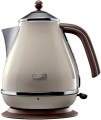Design
The design in which the electric kettle is decorated. In addition to
the classic design, nowadays there are more original styles, namely:
—
Retro. Devices stylized antique — mainly for kitchen utensils of the 30s — 50s of the XX century. The degree of stylization in this case can be different: for example, some appliances are not different from ordinary kitchen kettles that are placed on the stove. Also note that almost all samovars are performed in retro style (see "Type"). But thermopots and teapots in this design are almost never produced. Anyway, a retro kettle will be indispensable for a kitchen in the same style, but it can also fit into a modern interior.
—
Hi-tech. The devices that have a technological, sometimes even futuristic design — using unpainted metal, transparent glass, as well as a minimal amount (or even complete absence) of decorative details. At the same time, the design can be quite unusual: for example, there are models that taper upward and vaguely resemble laboratory flasks. Like the retro style, almost no other devices are produced in this style other than classic kettles.
When choosing a device in a specific design, note that the design inevitably affects the cost — sometimes quite noticeably, despite the fact that it usually does not provide functional advantages.
Power consumption
The power consumed by the kettle during operation is actually the power of the heating element installed in the device.
Two working moments depend on this parameter: heating intensity and electricity consumption. On the one hand, the
high power of the heater allows you to quickly heat up a certain volume of water and saves time. On the other hand, the power consumption of such a device will also be appropriate. The wattage of a kettle's heater typically does not have a significant impact on electricity bills since the energy consumption required to heat a given volume of water remains the same regardless of the heater's power rating. However, there may be certain issues related to electrical connectivity. For example, if the wiring is weak or the fuses are improperly sized, the operation of a high-power heater may cause power outages. Additionally, devices with a power rating greater than 3500 W cannot be connected to a regular electrical outlet and require a specific power format. Consequently, even the largest thermal pots, which typically have a capacity of 10 L or more, are rarely equipped with heaters more powerful than 3000 W, since this power rating is sufficient for their intended use and can be connected to a standard electrical outlet.
Thermostat
A device that allows you to set the temperature to which the water will be heated — the
thermostat monitors the temperature and automatically turns off the heating when the desired value is reached. In fact, water heated in a kettle does not always need to be boiled: for example, for brewing some types of tea, the optimum temperature is about 80 °C, and for preparing baby food — 60 °C. Thermopot are most often equipped with a thermostat, but there are also classic electric kettles with such a function.
Temperature adjustment
The temperature adjustment capabilities refer to the specific temperature values that can be programmed into the electric kettle. It's important to note that this refers to automatic adjustment, where the kettle turns off or switches to temperature maintenance mode once the desired temperature has been reached.
If this paragraph contains several options separated by commas (for example, “60 °С, 80 °С, 90 °С”), this means that this model has several fixed temperature options. However, there are also devices with
smooth adjustment, which allows you to adjust the temperature in steps of 5 °C, or even 1 °C; for such devices, the entire adjustment range is indicated here, for example, "60 — 100 °C".
The greater the number of temperature setting options available in an electric kettle, the more versatile it becomes, allowing for precise selection of the optimal brewing mode for various types of drinks. Here is a simple table of recommended temperatures:
—
white tea — 60 °C;
—
yellow tea -70 °C;
—
green tea — 80 °C;
—
black tea — 90 °C;
— rooibos, hibiscus — 100 °C (up to boiling);
—
baby food — 40 °C.
Of course, there are exceptions to such rules — depending on the specific type of drink. For example, some
...varieties of green tea can be brewed at 90 °C.Maintaining t° (kettle)
The ability to operate a classic kettle (see "Type") in the mode of
maintaining the water temperature — when the heated water is kept hot due to the operation of the heater at low power. For kettles, unlike thermopots, this mode is far from necessary, so its presence is indicated separately in the specs.
Removable lid
The ability to completely remove the lid of the kettle. Such a possibility is not of particular importance during regular use, however, it provides additional convenience if the kettle needs to be washed from the inside — a
removable lid, unlike a traditional non-removable one, will not hang on the fixture, hit your hands and create other discomforts. On the other hand, there is a certain risk of losing this lid, so this feature is not common.
Opening the lid with a button
Kettles (see "Type") in which the lid opens at the touch of a button. This opening is faster and more convenient, and often safer than the traditional way (grab the lid and pull it up): the lid can get quite hot when the kettle is in operation, and long contact with it is fraught with burns. And although the button can also be placed on the lid, a short press is enough to activate it, and even in such cases the risk of getting burned is minimal. On the other hand,
opening the lid with a button complicates the design of the kettle and reduces its reliability.

